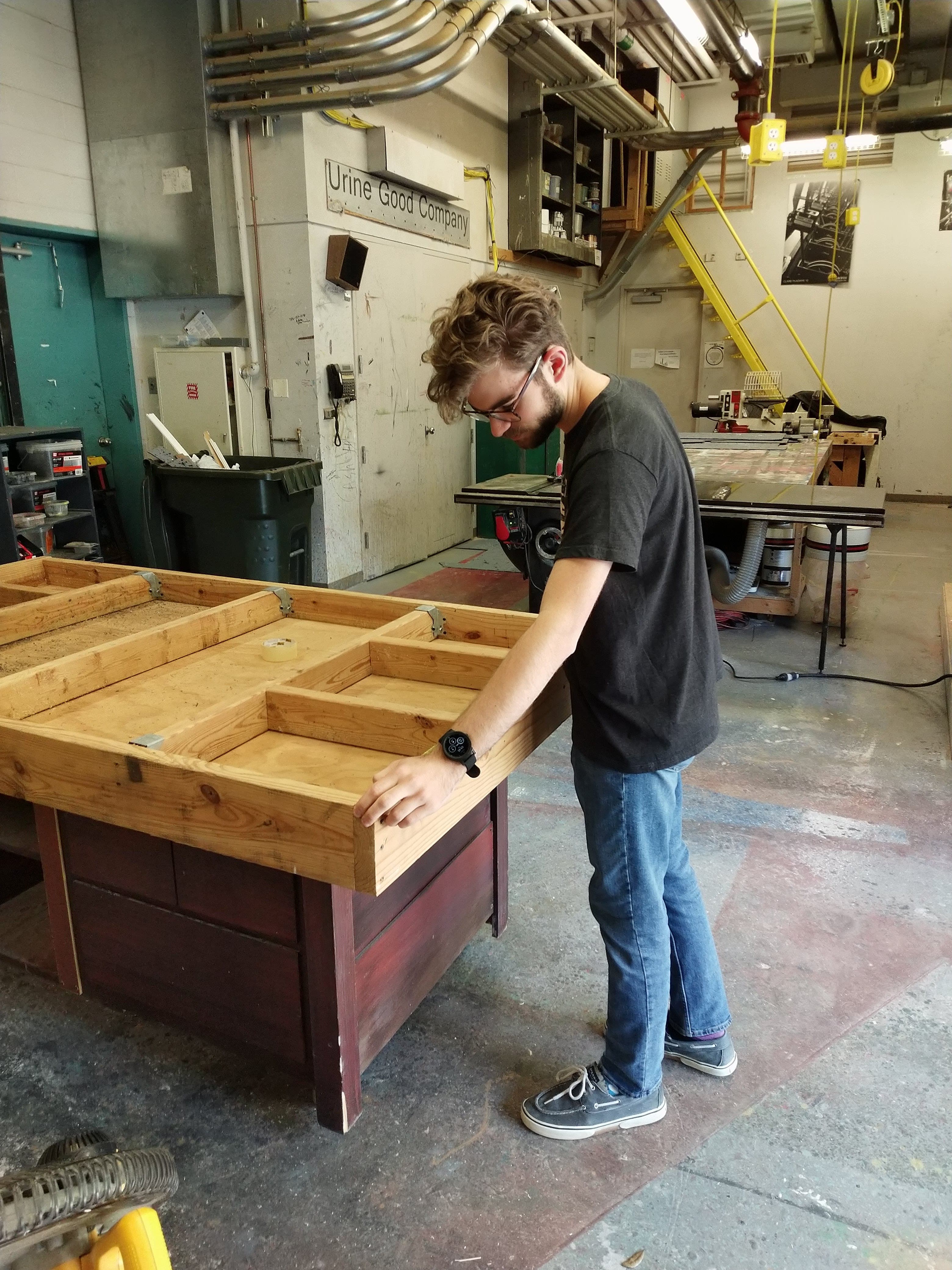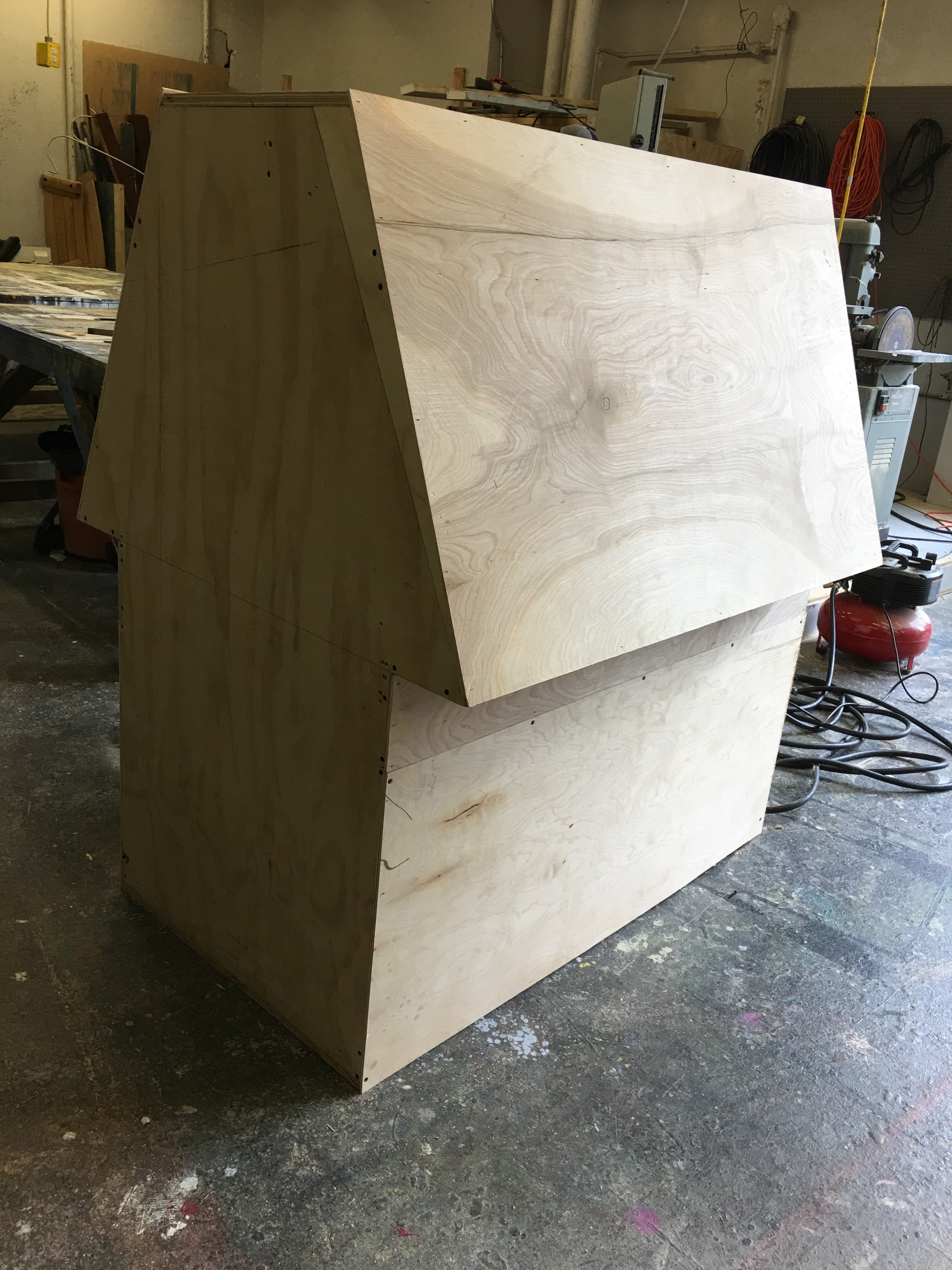Academics
Please click to see work from each class or scroll for all classes.
A practical activity-based and lecture course which specializes in the study of various paint finishes and techniques that are applied to stage scenery. When working on class assignments, students will have the opportunity to experiment with paint, binders, tools and techniques. The techniques covered serve as a foundation for further study and exploration in the art of scene painting.
Fall 2019 - John Ore
The goal of this course is to introduce the pre-production, production, and post-production aspects of on location video and film production. Students will be instructed on pre-production concepts, production techniques, and editing theory and practice. This course will cover the development of the initial concept, writing, shooting on location, and making it all come together in the editing room.
This course explores the relationship between social, political and cultural occurrences and fashion, art and clothing by focusing on selected periods in history, social and cultural movements, trends, style and fashion and their impacts on specific groups of people. Topics vary from traditional chronologic period study to the age of the fashion designer to the Industrial and Technological revolutions.
Theory and practices of playwriting. Includes the writing of scripts for theatre reading and production.
Spring 2018 - Joshua Bond
Spring 2018 - Sergio Costola
Spring 2018 - John Ore
Spring 2018 - John Ore
Spring 2018 - Sergio Costola
Summer 2017 - John Ore
Spring 2017 - Patrick Anthony
Spring 2017 - John Ore
Spring 2017 - Desi Roybal
Fall 2016 - Justin Smith
Fall 2016 - Paul Gaffney
Lighting Design
Spring 2018 - John Ore
Visual Design Analysis and Story

Visual Design Elements
- Line
- There is a string diagonal line in this painting with a bright strip coming in from the top left and going towards the girl on the swing
- Every figure(including sculptures) on the painting is looking at the girl which creates implied lines to add emphasis on the girl
- Shape
- A triangle is created between the two men and the girl on the swing, this draws attention to the top of the triangle(the girl) and has the two men as major aspects of the painting
- Mass
- All of the people are about the same size but the girl is in a large flowy dress which increases her size and importance.
- Color
- The girl is dressed in pink which the rest of the painting is green and blue, the pink highlights her and makes her a more important part of the painting.
- The two men are hidden in the shadows and painted darker than many aspects of the painting
- Value
- The value of the girl is much greater than that of any of the other painting being a light pink with the painting being much darker than her.
- Texture
- The texture of the trees are interesting with detail for each leaf in the foreground and a simple texture for the background trees
- The dress on the girl is very flowy and has a much lighter texture than the other elements of the painting.
Visual Story
There is a young women and two men in a small clearing in a forest. She gracefully swings in the center of the portrait in a bright, flowing pink dress. She is being pushed by one man from behind and one watches her from the front. Both of the men are hidden in the shadows as they watch over her.
This group of three has spent the afternoon together on the edge of her family’s home. After some time they find a nice clearing the the woods. Some of her family’s forgotten statues remain in the clearing. They decide to hang a swing on one of the trees in the woods so that she could have some fun. After everything was set up, she climbs on the swing as one of the men push her while the other chose to lie down and relax as the other man helped her swing. She notices him looking up at her and decides to playfully kick her shoe off at him. She wore her greatest dress to impress these two and hopes the dirt of the forest won’t tarnish its beautiful pink color. Show knows that she is beautiful and has these two men interested in her but she must now make the difficult choice between the two. She has been weighed down with the thought that she must make a choice but right now all she can think about is how great of a day it has been and the swing is the perfect way to end it. All that can be heard in the woods is her gentle, playful laughter as she happily swings back and forth. Once she grows tired of the swing, they make it out of the woods and the two men return her home where she must choose who she wishes to be with.
Principles of Visual Design Composition
- Balance
- The painting is fairly symmetrical with the girl on the swing in the center of the painting trees on either side, and two men on the sides of the picture
- It has mostly positive space with trees occupying the majority of the painting filling in what would otherwise be negative space
- Harmony
- It has a very nice harmony, the whole piece uses triangles and lines to create a very calm, complete image
- Proportion
- The girl is slightly larger and therefore closer in the painting compared to the other men at the base of the painting, but the visual elements with the light also highlight the girl, apart from her size.
- Rhythm
- The leaves of the trees follow a rhythm, but apart from that there are not many repeating elements to this painting
- Emphasis
- The girl is heavily emphasised, she is wearing a lighters color than anything else in the painting, the light is directly on her and no one else, there are multiple lines that point directly to her, she is the top of a triangle with the two men. Everything that is done in this painting is done to emphasis the girl.
Natural Lighting Project
![Recreation in Class]()
![Reference Image]()
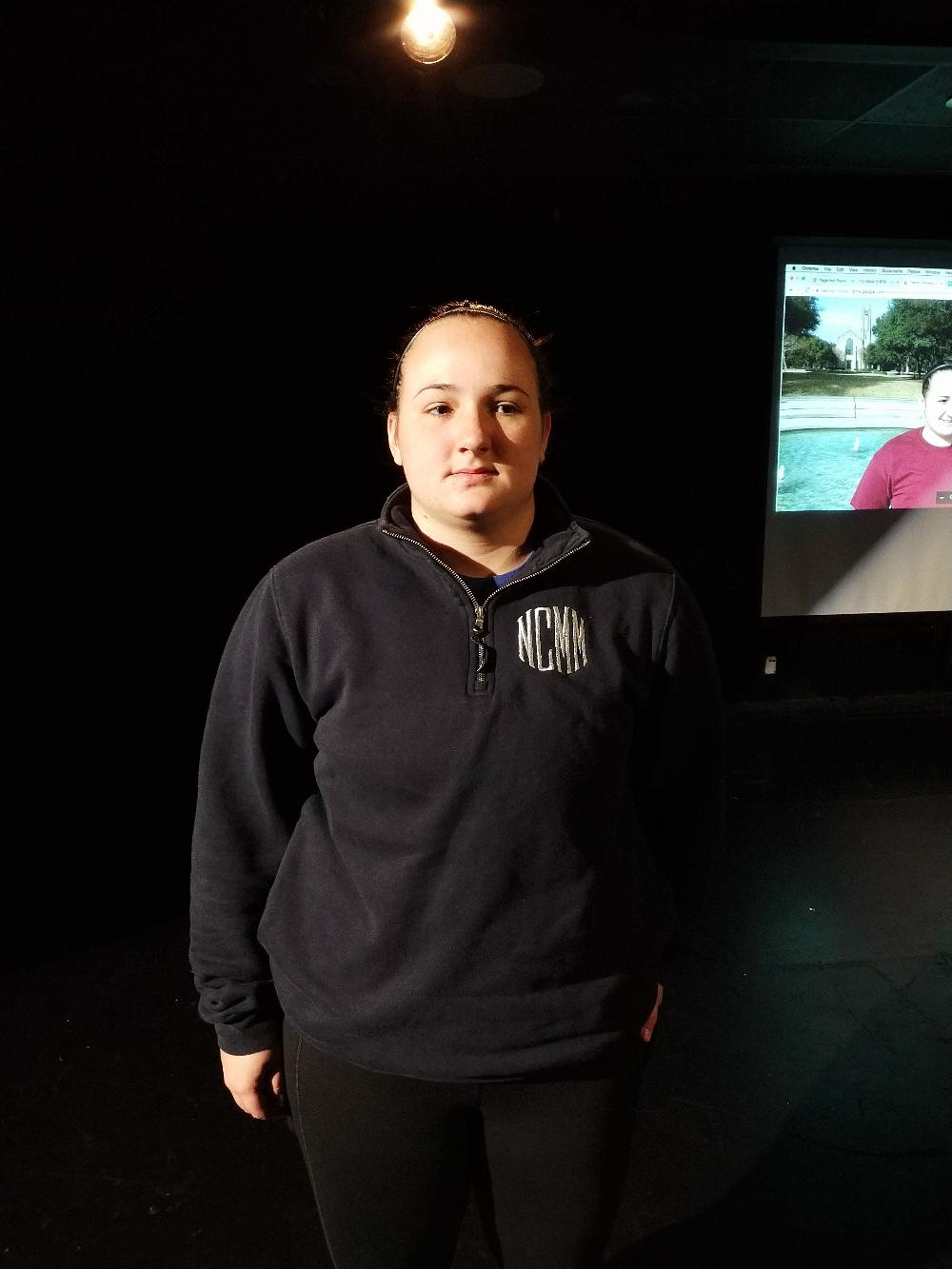
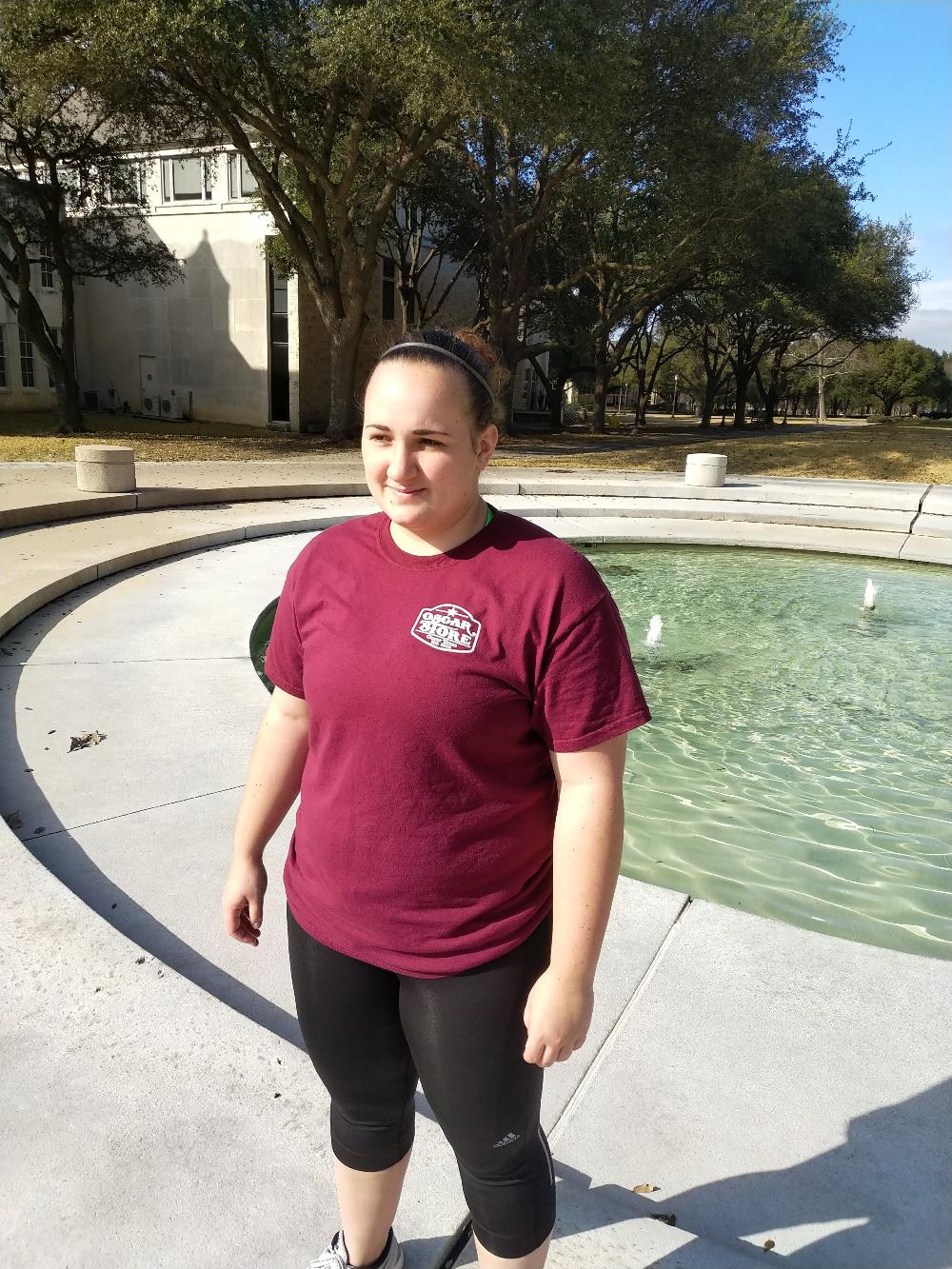
During the observation period, the light was very warm and bright on Nacona’s face. Shadows were very sharp with ambient light coming from the sky and bouncing off the sidewalk. As we were outside, I could slowly see the shadows start to get longer but not much changed in the 20 minutes we were outside. Half of her neck was covered with a deep shadow and the top of her head was lit by the sun and warm.
During the process of making the cue, it was important to us that the color and intensity matched as close as possible. We spent an hour in the black box trying different combinations of gel and intensity. We were able to get the shadows look right almost right away by using only channel 1, 3, and 8. The intensity of channel 1 was 45, channel 3 was 100, and channel 8 was 30. Channel 3 was acting as the sun so that it would cast the shadows properly, channel 1 and 8 were both ambient light sources from the reflection in the sky and backlighting on the top of our head. Finding gel color combinations that worked best was the most difficult part of the assignment. We went through multiple gel in the three lights to try to see what would work the closest to our outside image. After a while, we found that a L203 in 1 and 3 and a L206 in 8 was very close to the original image that we were trying to create. Nothing that we found fit the image perfectly with some of the combinations being too blue, too amber, or too green. We thought that the combination we found was the one that most closely resembled our original image.
During our class presentation, the class thought that our lighting was too orange and we changed the gel in channel 3 to a L202 and that cooled it to look more like the image. Strangely in the images that I took with my phone, the photo before class looks cooler than the picture after class but I do not know why that would be the case because the only thing changed between the two images was the gel in channel 3 which is now a cooler gel than the L203. I do think that in the images that I have, the one after the class evaluation more closely matches the images from the outdoor photographs. However, after seeing Nacona in outside and in the stage light in person, I think that the original cue more closely matches what I could see. When we were creating the cue in the black box, I think that I compared it to the image “photo reference 3” but in class I used “photo reference 1,” the third image seems to have a different exposure and has a slightly different look than the image I used in class and has a closer resemblance to the image before class. The slight adjustments were nothing major and we were still able to get the shadows correct before our class presentation.
Kiara Morales and her partner, that I unfortunately did not catch the name of, had 9 in the morning. Kiara originally did not use much gel in her cue and the outcome was far too amber. The morning sun had many more colors in it that were not in her recreation. After the class viewed, they decided that it needed more blue and she put in a 203 in channel 3 which helped a lot and made the cue look a lot more like her reference image. She was able to get the shadows right in her original cue so she did not have to change any of the intensity of the lights that she used. She used backlights with a L203 on the left and right and a L218 in the middle back which helped keep the cue cool like the reference image. After adding the color corrective gel, the cue looked much more like the original image and looked more natural.
Kiara’s partner had a different cue than she did and had L202 in every light around her which looked almost exactly like the original image. Although they had the same time of day, they took their picture on different days and Kiara had a sunny day while her partner had an overcast one so the shadows were different for the two cues. The low intensity of the lights and every light having a L202 gel made it look as close to the image as she could probably get.
Emily Scott and Chelsea Banawis had 5pm and they each had their own separate cues like the 9am group. Emily’s original cue was too blue using several L202s and L201s and the cue had too much intensity with the saturated colors. After Emily reduced the intensity of several of the lights, it was a much closer match to the reference image. The day that they took their pictures was overcast so there were not many shadows and Emily used all of the lights to reduce any shadows as much as possible. Chelsea had a different cue than Emily that was much warmer but matched the image closer than Emily’s original cue. Her cue looked a little warmer than the image too me but it was very close and looked almost exactly like the image that they took. Chelsea also used all of the lights to reduce the shadows as much as possible.
I learned from this project through my own experience with trying different intensities and gel to create the proper look and the process that other people went through and seeing their outcome on stage. It is difficult to get the stage light to look exactly like the outside, but with trial and error, it can eventually be close.
Macbeth Lighting Design Project
Video to the right shows the lighting effect made for the scene design. The scene took place outside the castle with the witches on a dark and stormy night.
Concept
To highlight the theatricalness of the witch scene with non-realistic colors and flashing lights that highlight the creepiness of the witches.


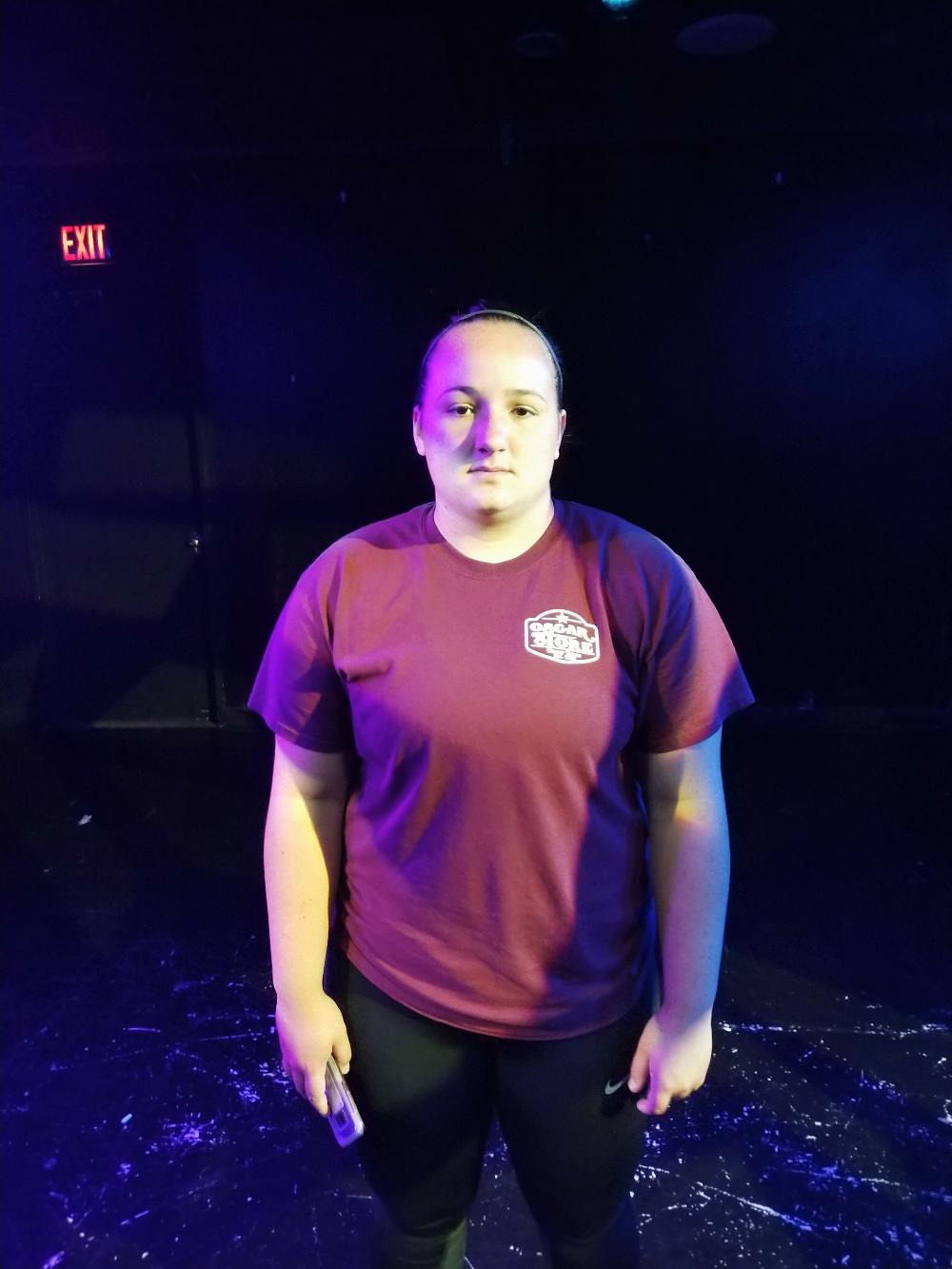


Cue/Intensity Sheet
Film Production
Fall 2019 - Andrew Richey
The goal of this course is to introduce the pre-production, production, and post-production aspects of on location video and film production. Students will be instructed on pre-production concepts, production techniques, and editing theory and practice. This course will cover the development of the initial concept, writing, shooting on location, and making it all come together in the editing room.
Seeing Film
Film with no actors that I wrote, directed, and sound designed.
Saint Matthews United Methodist Weekly Service
The Horse Film
St. Matthews UMC Live Service
Scenic Design
Desi Roybal - Spring 2018
An introductory study of the art and practice of lighting design. Students are introduced to the unique process via hands-on lighting projects in the departments performance spaces. Design projects include recorded observations of natural and artificial lighting sources followed by the study and research of a selected classic painting. Related topics include additive color theory, lighting in a variety of theatrical spaces, and working with incandescent and LED fixtures.
A Game’s Afoot Scenic Design
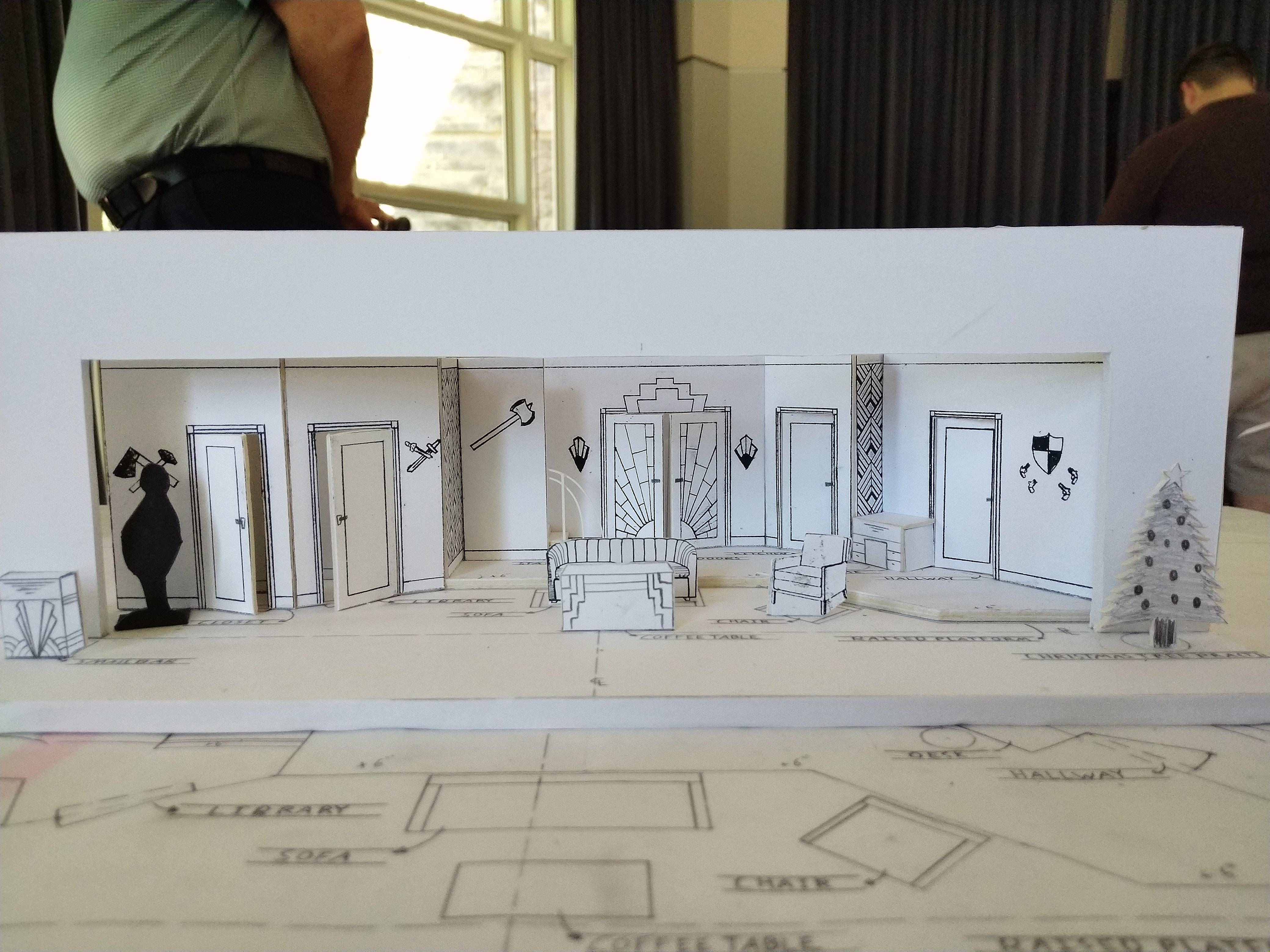
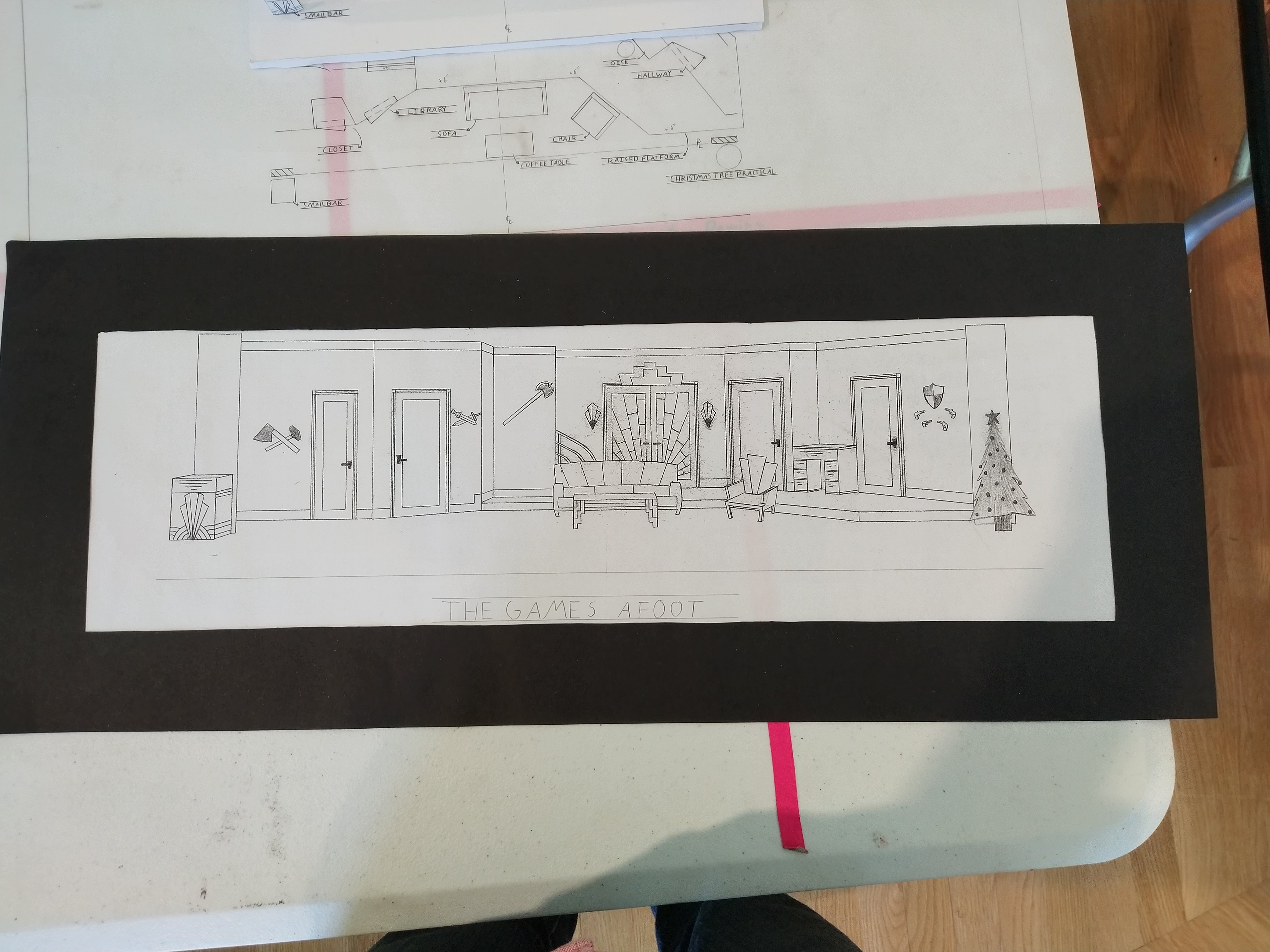
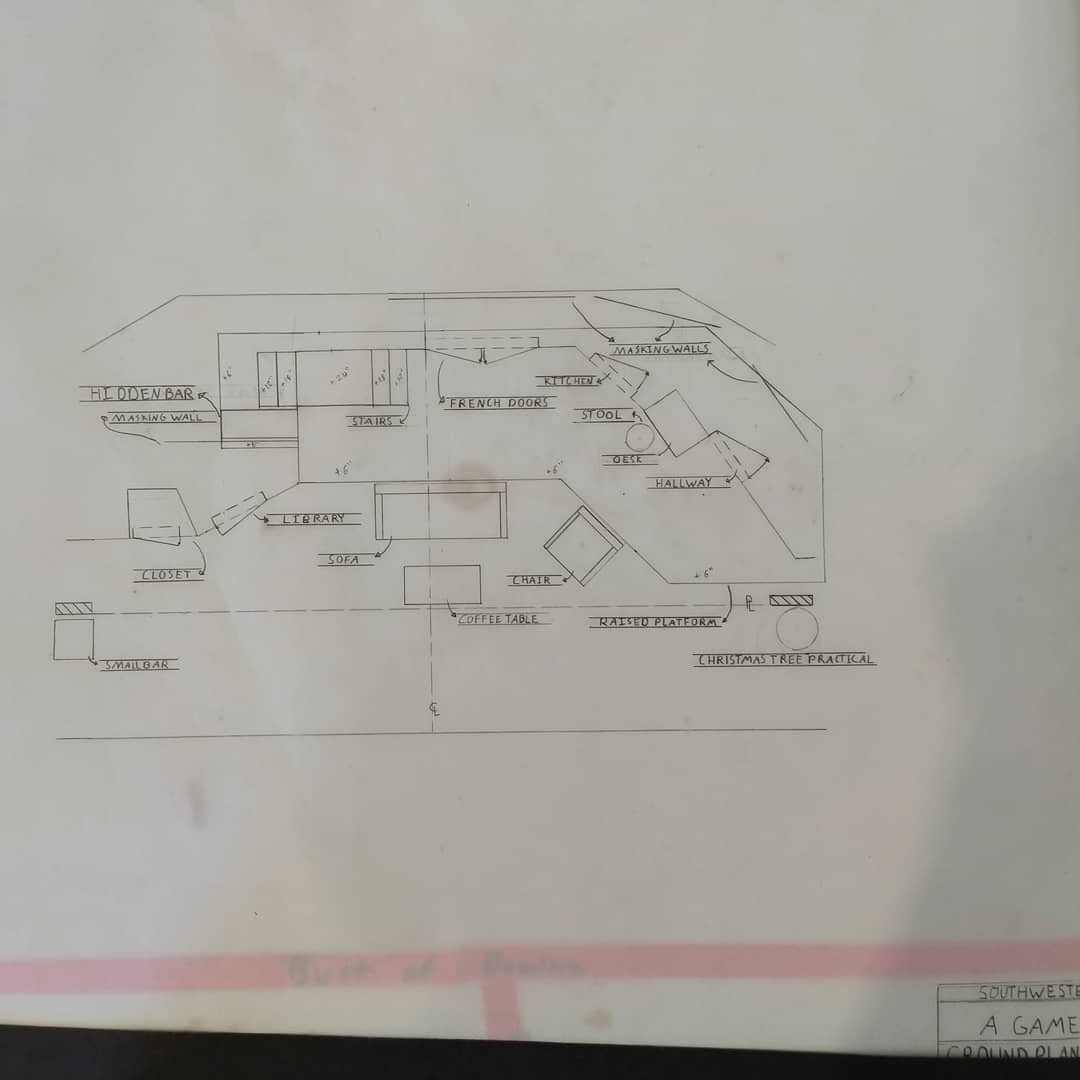
Icon Project
This assignment was to create a three-dimensional space based on the Southwestern University Logo. I created an outdoor concert venue. My design changed as I went through the project, starting as a proscenium stage and changing to a concert space. I used SketchUp to create a rendering of the space then executed the project with foam core.

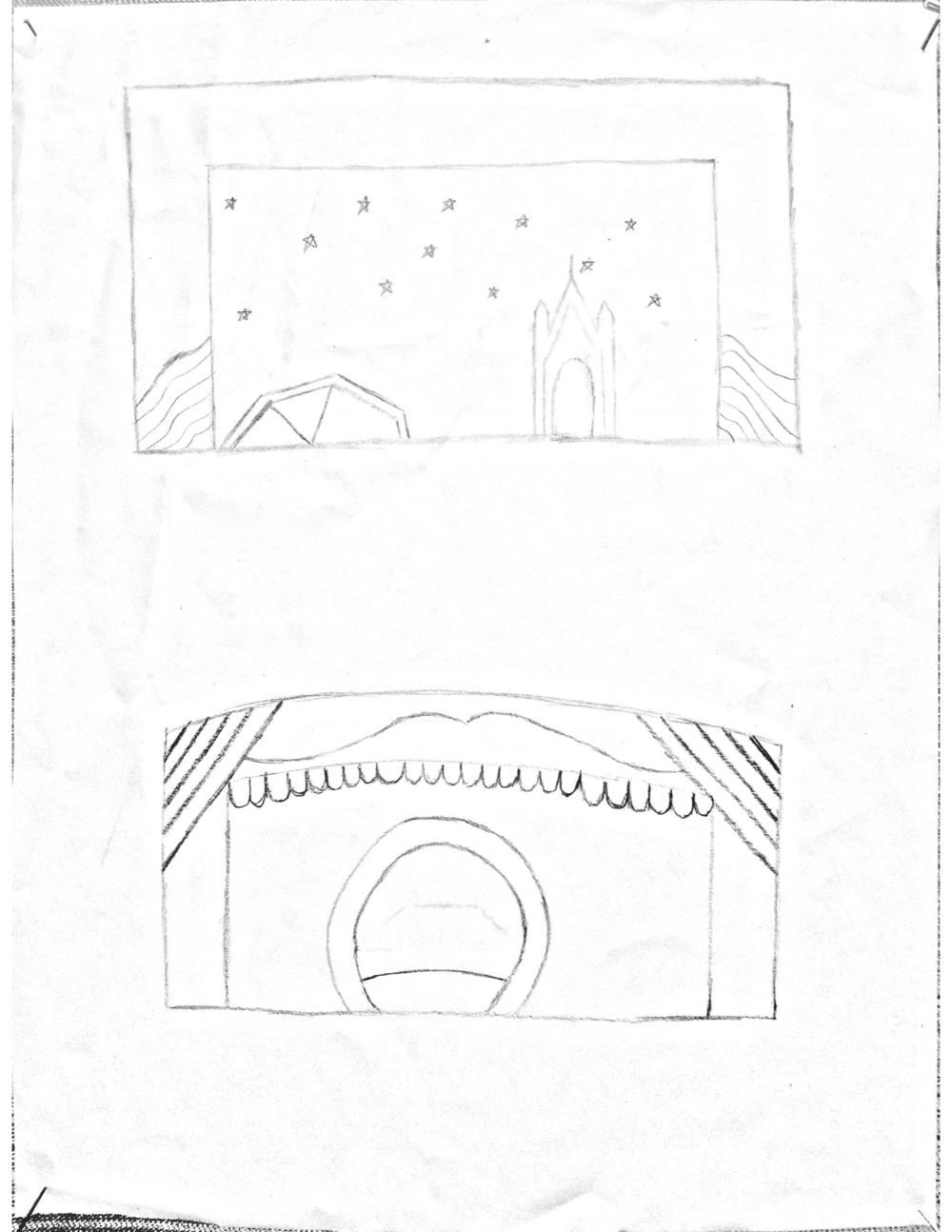

Icon Project Abstract
I created this project as the stage to a concert festival. I picked apart the elements of the logo and used them in different areas on the model. The steps leading up were created using the chevron stripes on the shield. On the arches, I used stars, circles, and diamonds that were all taken from different parts of the logo. At the back of the stage is a shield with a large star and 1840. It was important to me that there would be different viewpoints depending on where the audience was sitting, so I layered the arches in front of each other to create a different view from every angle.
I went through several design ideas before settling on this one. I started wanting to create a proscenium theatre, as my early sketches show. Once I started working on it more, my ideas shifted to create the circular concert stage. I used Sketchup to draw out a 3D model for what I planned on creating and followed that file to create the model. Because I went through several iterations, the design process took several hours to complete and I continued to change several elements as I built the model. I found that the Sketchup model was entirely too large and had to reduce the height by about 10 scaled feet. I enjoyed the design process and the creation of my model, it took many hours to complete but the result is exactly what I wanted out of my model.
It was important to me that the logo would not be directly seen in the design, but elements from the logo would be incorporated which is the reason I chose certain elements to use. I wanted the design to have spectacle but also be relatively simple so I decided to use a few icons in certain areas instead of cluttering the design with a lot of images. This project showed me that I enjoy design and is something that I plan on continuing to do and improve at.
I went through several design ideas before settling on this one. I started wanting to create a proscenium theatre, as my early sketches show. Once I started working on it more, my ideas shifted to create the circular concert stage. I used Sketchup to draw out a 3D model for what I planned on creating and followed that file to create the model. Because I went through several iterations, the design process took several hours to complete and I continued to change several elements as I built the model. I found that the Sketchup model was entirely too large and had to reduce the height by about 10 scaled feet. I enjoyed the design process and the creation of my model, it took many hours to complete but the result is exactly what I wanted out of my model.
It was important to me that the logo would not be directly seen in the design, but elements from the logo would be incorporated which is the reason I chose certain elements to use. I wanted the design to have spectacle but also be relatively simple so I decided to use a few icons in certain areas instead of cluttering the design with a lot of images. This project showed me that I enjoy design and is something that I plan on continuing to do and improve at.
Scenic Painting
Fall 2019 - Desi Roybal
A practical activity-based and lecture course which specializes in the study of various paint finishes and techniques that are applied to stage scenery. When working on class assignments, students will have the opportunity to experiment with paint, binders, tools and techniques. The techniques covered serve as a foundation for further study and exploration in the art of scene painting.
Paintings done in class
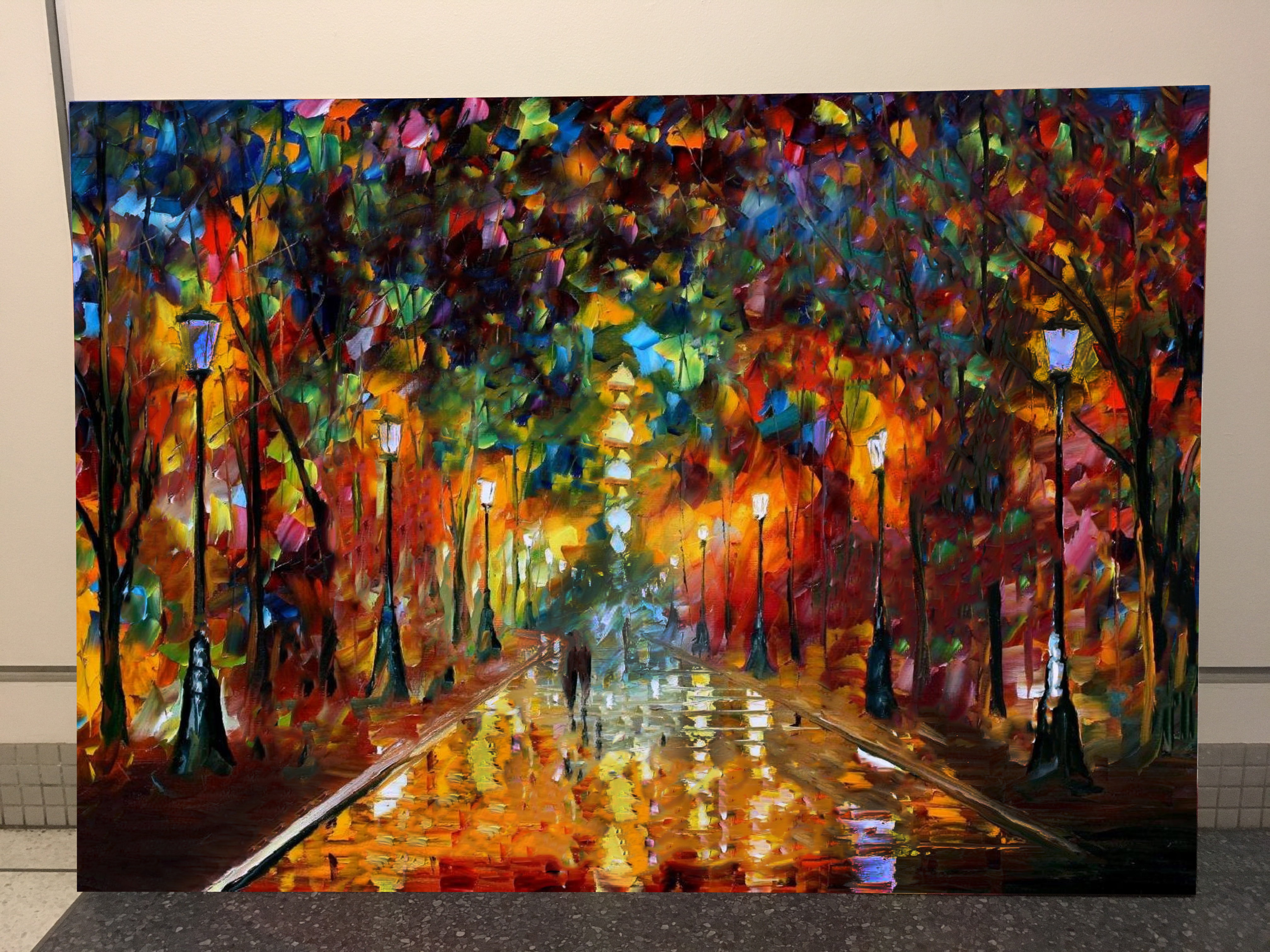
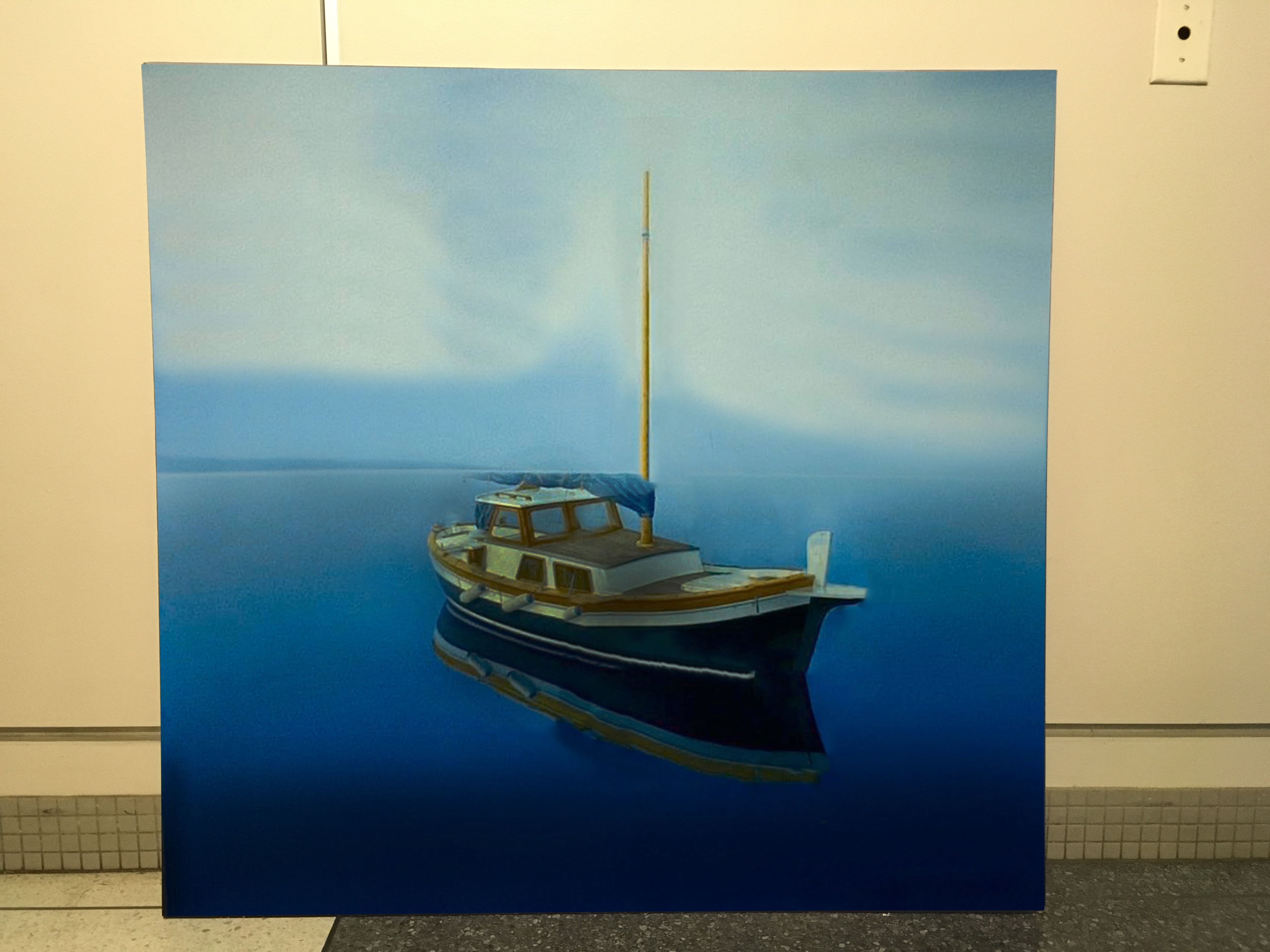
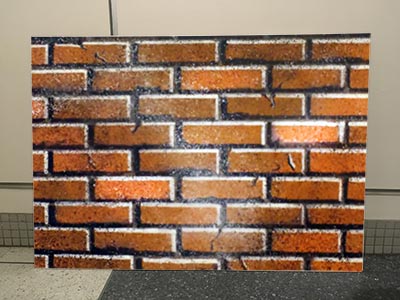
Audio Design & Technology
Fall 2019 - John Ore
An introductory study of theatre sound systems and design for theatrical performance. Using the systems in the Department's performance spaces, students will become familiar with mixers, effects processors, amplification and microphone technology. Students will experience the design process and gain hands-on experience as assistant designers, audio engineers and programmer/operators in plays produced by the Department.
Aural Landscape

An auditory landscape for Delacroix’s Liberty Leading the People.
Voiceover Recording
Design Fundamentals
This beginning design course provides students the opportunity to explore the major areas of design for theatrical production: costume, scenery/props, sound and lighting. Students will be exposed to theatrical drawing, rendering, script analysis and collaboration. The format of this class will vary from discussion to lecture to group activities. This course is open to only first year students and sophomores. Juniors and seniors may register with the permission of the instructor.
Classwork
.







Festival Stage Management
This project-oriented course surveys the job of the stage manager and the work "behind the scenes" of live performance with the emphasis on theatrical production. Our goal will be to become competent in the area of stage management, which will be realized through study, discussion, and (most of all) hands on experiential learning.
Summer 2017 - John Ore



One Man, Two Guvnors by Richard Bean
Role: Rehearsal Stage Manager
Over the summer of 2017 I took Festival Stage Management where I was rehearsal stage manager for a 50 minute one-act cut of One Man, Two Guvnors. At the festival, I was able to work with directors and designers across the state. During the class and through the process of the show, I was able to learn about the stress and format of a theatre festival with the differences of working on a single show.
Sample Production Analysis

Sample Character/Page Breakdown

Production Stage Management
An introduction to stage management for academic and professional theatre. This project-oriented course provides students with a survey of techniques and strategies aimed at modeling successful stage management. Students will gain hands-on experience by working in stage management in the Departments performance spaces.
Moon Over Buffalo
This work is from a non-realized production of Moon Over Buffalo for the Stage Management for Theatre class at Southwestern University. For this mock-production, I created a production analysis and character/page breakdown. To show a sample of blocking notation, we wrote the blocking from a Southwestern performance from 2015 shown at the bottom of this page.Sample Production Analysis
| Act Sc., P. | Cast/Costume | Set | Lights | Props | Sound | Special Effects | Special Notes |
| I/p.1 | George, 50s- Cyrano Small company members playing the other parts in 1640 battle costumes | Seige of Arras in 1640 in a battle | Lights come up with actors in silhouette | Tattered flags Musket and cannons Swords | Musket and cannon sounds Cries of a battle | Smoke | |
| 1/p.2 | Works lights on, then back to battle lights | Battle music stops, then resumes Horse and Carriage from offstage | |||||
| I/p.3 | Charlotte, 50s, enters as Roxane, she exits Ethel, 70s, enters in 1950's clothes | Basket of fruit, break, wine, chicken | Horse Whinnies | ||||
| I/p.4 | All exit but Ethel | Scene shifts to the green room, has chaise, large pouffe, esay chair, door to street, 3 doors to backstage, and utility closet | Shift to green room lighting | Theatre posters and other theatre things | battle sounds stop | ||
| I/p.5 | Roz, 30's, enters from street, modern 50s clothes | Roz suitcase | |||||
| I/p.8 | Ethel exits Howard, 20s, enters from street, modern 50s clothes | Knock at door | |||||
| I/p.12 | Roz exits | Cyrano hat in room | |||||
| I/p.13 | George enters, still in Cyrano costume Charlotte enters, also in Cyrano costume | Cyrano nose Two swords | May need sword training |
Sample Character/Page Breakdown
| Page | 1 | 2 | 3 | 4 | 5 | 6 | 7 | 8 | 9 | 10 | 11 | 12 | 13 | 14 | 15 | 16 | 17 | 18 | 19 | 20 | 21 | 22 | 23 | 24 |
| George | X | X | X | X | X | X | X | X | X | X | X | X | X | X | X | X | ||||||||
| Charlotte | X | X | X | X | X | X | X | X | X | X | X | X | X | |||||||||||
| Roz | X | X | X | X | X | X | X | X | X | X | ||||||||||||||
| Howard | X | X | X | X | X | X | X | X | X | |||||||||||||||
| Paul | ||||||||||||||||||||||||
| Ethel | X | X | X | X | X | X | X | X | ||||||||||||||||
| Richard | ||||||||||||||||||||||||
| Eileen |
Sample of Blocking Notation and Cue Calling Script
I did not create blocking notes for Moon Over Buffalo as there was no show to record blocking on. Instead, the class recorded the blocking for a performance done by the Mask and Wig organization for the annual Sing! competition. Below are some pages from the performance showing my notes for blocking and cues.

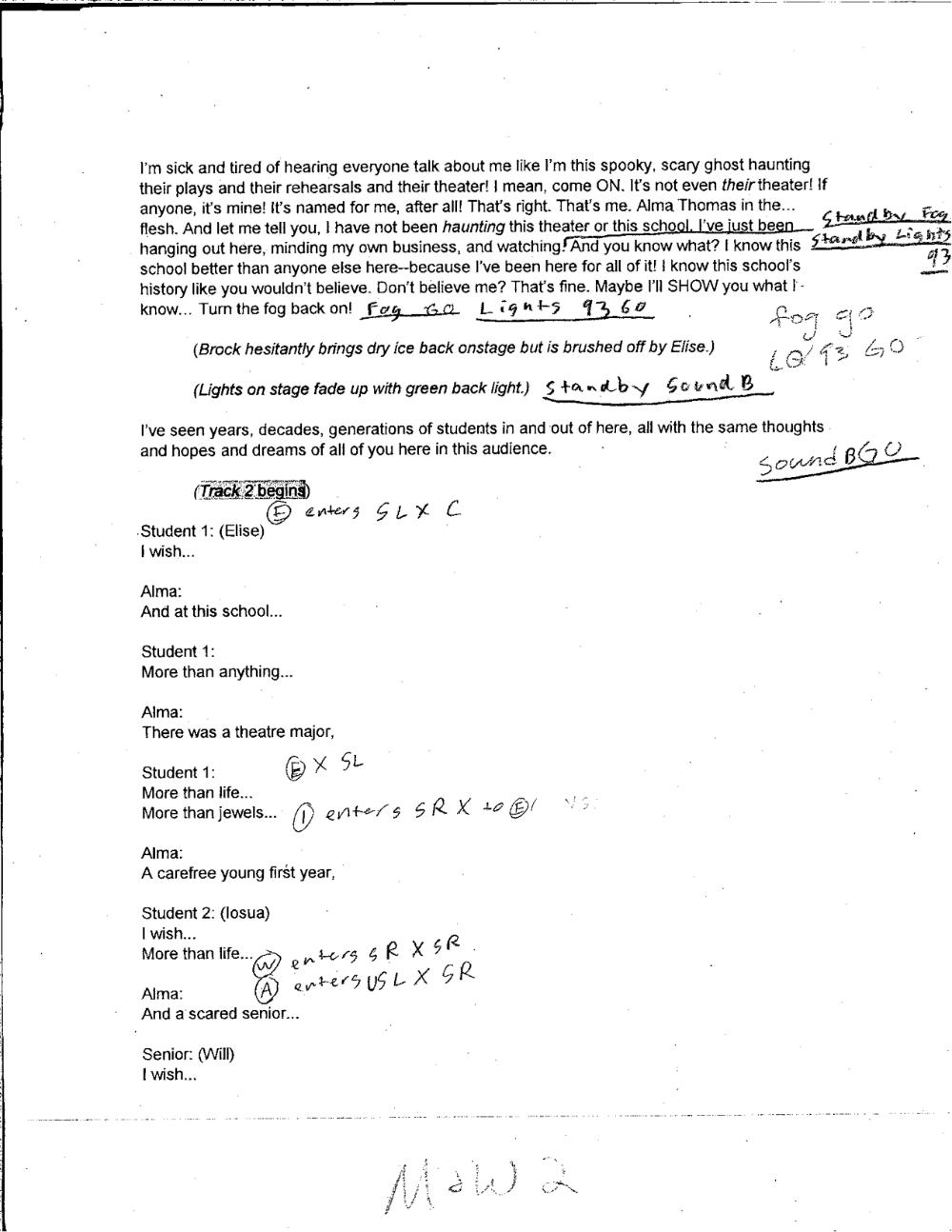
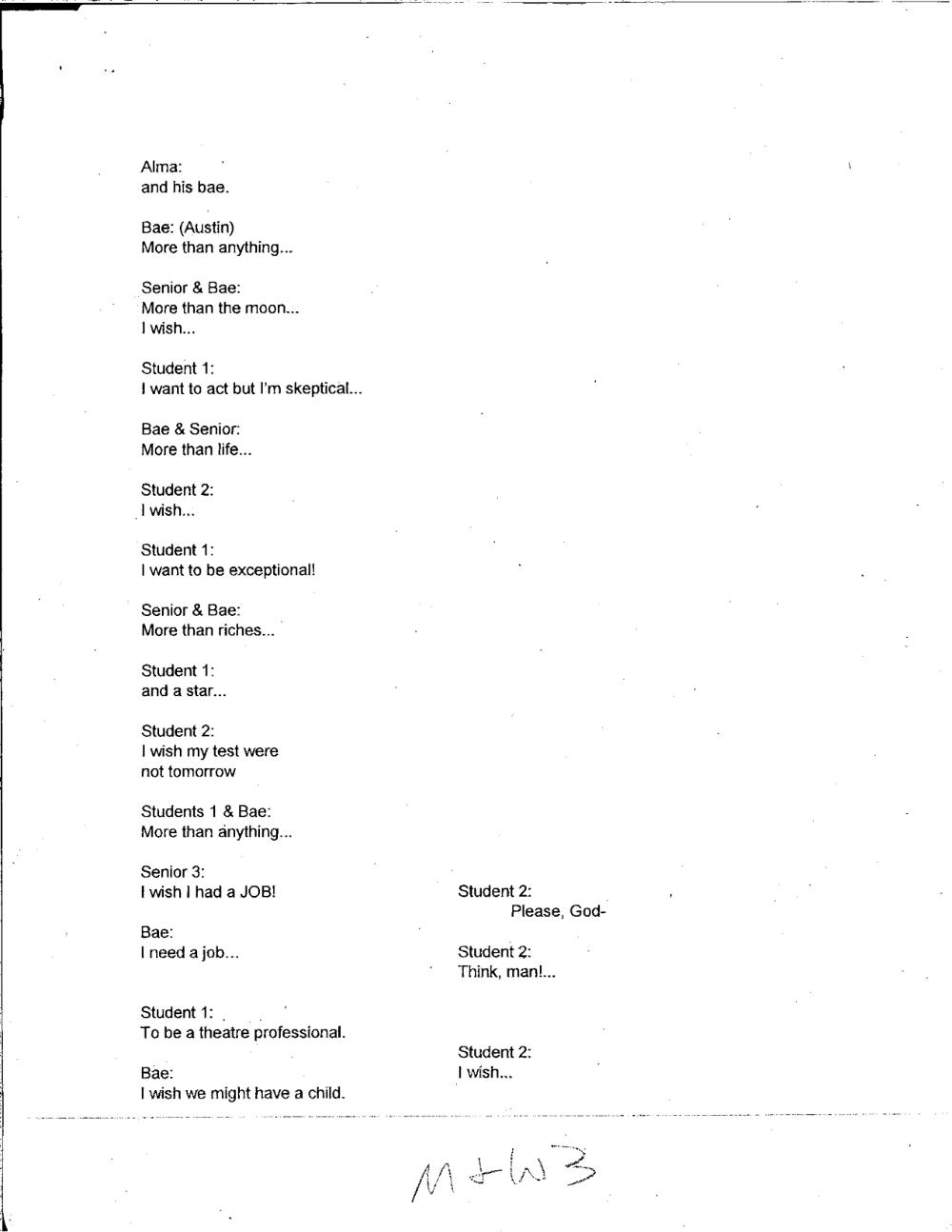



Playwriting
Spring 2019 - Elizabeth Doss
Theory and practices of playwriting. Includes the writing of scripts for theatre reading and production.
Below is the play I wrote for the class.
Fundamentals of Acting
This course is designed to introduce students to the processes of acting, including developing clear characters, analyzing scripts, exploring dramatic action and conflict and making bold choices in the development of scenes and monologues. Students will work on basic acting skills including movement, voice, and improvisation. Substantial written and performance work is required.
Samples of work from course.
Intro to Play Analysis
Spring 2018 - Sergio Costola
A course exploring various critical approaches to Western written texts intended for the stage. The selection of plays will help students develop the ability to analyze and evaluate a variety of scripts in terms of form, structure, tone and style. Students will be introduced to some of the most important realistic plays of the twentieth century while also exploring texts that depart from realism.
1834 New York City Riots Narrative
Before the riots began on July 7th, there were many race issues sprouting in the city of New York. According to July 7th’s edition of the Commercial Advertiser there was a march by “colored brethren” after having a mixed worship with whites on the 4th. In the Chatham Street Chapel, whites and blacks sat in alternate rows but no whites joined them on their march. The blacks were also selling spirits in plain sight of the public in the vicinity of a church on Laight-street. These events raised race conflicts in the city, helping lead to the riots that followed several days later.
At the former theatre turned church, Chatham-Street Chapel, the Sacred Music Society met on their usual Thursday but were unaware that the chapel had been leased to a black congregation which the society became upset about. The members of the black congregation refused to leave which resulted in a fight between the two groups. The Commercial Advertiser reported that “chairs and benches were broken into clubs” and also admits that blacks “are far less guilty than the reckless fanatics who urge them on. The Evening Post of that same day writes that the morning papers used “very inflammatory language” when “there was fault on both side, and more especially on that of the whites.” The paper reports that the blacks reserved the chapel and the people to first arrive for the Sacred Music Society agreed to let them have the space, but as more arrived they reversed their decision and “took forcible possession of the pulpit” It was then that a battle took place between the two groups.
The July 9th edition of the Commercial Advertiser stated that the report from the day prior was not entirely correct because the space was reserved through the secretary of the Sacred Music Society and not the president, Justice Lowndes. This edition of the paper also writes of a riot at Clinton Hall. White men met to discuss “moral and political subjects,” the question posed for this meeting was “whether immediate abolition of slavery was expedient or feasible.” The blacks heard of the meeting and thought it was an abolitionist meeting and took possession of the meeting. A fight broke out between the two groups similar to what happened at the Chatham-Street Chapel.
The July 10th Commercial Advertiser reports three more riots that occurred the night before. One occurred at the Chatham-Street Chapel during an abolitionist meeting, one at the Bowery Theatre, and the third at the house of Lewis Tappan. At the chapel was an abolitionist meeting which resulted in an uprising, the paper also claims that the abolitionists are the worst enemy of the blacks in the city because they give them the belief that they are equal to whites. At the Bowery theatre, the English stage manager used “language disrespectful to the Americans” by talking out against slavery. The riots demanded that they stop the production of Metamora which they were able to achieve with the authorities arriving and clearing the building. After the events at the theatre, the crowd moved on to the house of Lewis Tappan where they “broke open the door, smashed the windows, and threw furniture into the street.” They then lit the bedsheets on fire and order was not restored until two in the morning.
Performance Review
A Funny Thing Happened on the Way to the Forum. Book by Burt Shevelove and Larry Gelbart, Music and Lyrics by Stephen Sondheim. Directed by Joey Banks. Alma Thomas Theatre, Sarofim School of Fine Arts, Southwestern University, Georgetown, TX. 1 March 2018.
This farcical musical, inspired by the plays of Plautus, follows the slave Pseudolus (Christian Aderholt) as he attempts to help his owner escape with a slave from the brothel next door in exchange for his freedom. It has seen success on Broadway in 1962 and 1972 as well as a feature film in 1966. Southwestern produced a different spin on the golden-age musical with a stylized show utilizing a very cartoonish set, costumes with elaborate wigs, and Vegas-style lighting. The show had many comedic moments with short bits and jokes that the audience reacted with many laughs and cheers.
The plot focuses on Pseudolus trying to earn his freedom from his owner, Hero (Clayton Brooks), who promises to free him if he is able to get Phila (Abigail Luna) with him. Seeing his struggle to become a free man shows the strong lines dividing the social classes of free citizens and slaves. As he attempts to get Philia and Hero together, he must further complicate his lie to many of the other characters including his neighbors, Lycus (Daniel Winkler) and Eronius (Ed Hillis), his owners, Domina (Cassidy Mayfield) and Senex (Chris Szeto-Joe), and Philia’s owner, Miles Gloriosus (Brendan Bowyer). All of the lies he told to become free drive the plot and create the many farcical moments. The text also sexualizes women and offers them as commodities to be traded rather than human beings with the ability to make their own decisions. This patriarchal aspect is very outdated and does not fit in with the current culture but was combated with clever choices from the director.
The director made some excellent choices to make the show very comical and to take away from the sexist nature of the script. For example, in the number Everybody Ought to Have a Maid, which is very explicit to the ownership of women, the production poked fun at it by having the characters joke about how they were singing the sexist song. The “slave in chief” to Senex, Hysterium (Tristin Evans), was a male character played by a woman who later in the script had to pretend to be a woman, was a very funny comedic bit and a great design choice.
The musical was in a proscenium theatre with a live orchestra located in a pit at the apron of the stage. It was a very good venue for the production with enough space to comfortably fit the three houses needed for the script and included enough playing space for the actors in front of the houses where all of the action took place. The production was very engaging with performers crossing all parts of the stage and filling the space with many of the musical numbers.
The stylized nature of the show carried through to the actors. Many of the characters, most notably Senex, had stylized walks in the fashion of a typical farce. However, this did not seem to be fully carried out, many characters did not have any sort of specialized walk that is expected with this kind of direction. Many of the comedic bits relied on short physical movements or simple one-line jokes. The choreography of the show was relatively simple, with a higher focus on the vocals of each piece rather than with intensive choreography. Pseudelous was a very strong actor carried the show with many subplots together, it was a very large role that he handled incredibly well. Hysterium was also portrayed very well and was very exciting to watch her scramble around as the lies caught up to Pseudelous and made her life more challenging.
The design of the show was done very cleverly with the set, designed by Desiderio Roybal, as three colorful and curvy houses painted with very bright colors. The lights, designed by Rachel Burke, were very flashy utilizing LED strips across the houses, Vegas-style light bulbs, and bright color washes across the stage. The costumes, designed by Kerry Bechtel, were very stylized, like the other elements of the show, and used large wigs of foam and bright costume pieces. All of the design elements came together for this show which created a very pleasing show to watch.
It was a very entertaining musical with great directing moments, design choices, and line delivery. From a fantastic and comedic start in Comedy Tonightto the Finale, the show was very entertaining and had many terrific moments. The farcical nature of the show combined with terrific actors made it a great comedy.
Theatre History
A course exploring Western theatre and drama in a variety of periods. Theatre performances and plays will be analyzed as functions of different fields of influence (economic realities of production and attendance; politics and power relations within and outside the theatre; social norms regarding gender, race, ethnicity, religion, family, etc; aesthetic values of the time). In addition, the course is meant to introduce students to methods of critical research and issues of historiography.
1934 New York City Riots Narrative
Before the riots began on July 7th, there were many race issues sprouting in the city of New York. According to July 7th’s edition of the Commercial Advertiser there was a march by “colored brethren” after having a mixed worship with whites on the 4th. In the Chatham Street Chapel, whites and blacks sat in alternate rows but no whites joined them on their march. The blacks were also selling spirits in plain sight of the public in the vicinity of a church on Laight-street. These events raised race conflicts in the city, helping lead to the riots that followed several days later.
At the former theatre turned church, Chatham-Street Chapel, the Sacred Music Society met on their usual Thursday but were unaware that the chapel had been leased to a black congregation which the society became upset about. The members of the black congregation refused to leave which resulted in a fight between the two groups. The Commercial Advertiser reported that “chairs and benches were broken into clubs” and also admits that blacks “are far less guilty than the reckless fanatics who urge them on. The Evening Post of that same day writes that the morning papers used “very inflammatory language” when “there was fault on both side, and more especially on that of the whites.” The paper reports that the blacks reserved the chapel and the people to first arrive for the Sacred Music Society agreed to let them have the space, but as more arrived they reversed their decision and “took forcible possession of the pulpit” It was then that a battle took place between the two groups.
The July 9th edition of the Commercial Advertiser stated that the report from the day prior was not entirely correct because the space was reserved through the secretary of the Sacred Music Society and not the president, Justice Lowndes. This edition of the paper also writes of a riot at Clinton Hall. White men met to discuss “moral and political subjects,” the question posed for this meeting was “whether immediate abolition of slavery was expedient or feasible.” The blacks heard of the meeting and thought it was an abolitionist meeting and took possession of the meeting. A fight broke out between the two groups similar to what happened at the Chatham-Street Chapel.
The July 10th Commercial Advertiser reports three more riots that occurred the night before. One occurred at the Chatham-Street Chapel during an abolitionist meeting, one ot the Bowery Theatre, and the third at the house of Lewis Tappan. At the chapel was an abolitionist meeting which resulted in an uprising, the paper also claims that the abolitionists are the worst enemy of the blacks in the city because they give them the belief that they are equal to whites. At the Bowery theatre, the English stage manager used “language disrespectful to the Americans” by talking out against slavery. The riots demanded that they stop the production of Metamora which they were able to achieve with the authorities arriving and clearing the building. After the events at the theatre, the crowd moved on to the house of Lewis Tappan where they “broke open the door, smashed the windows, and threw furniture into the street.” They then lit the bedsheets on fire and order was not restored until two in the morning.
Electrics Laboratory
2017-2019 - Patrick Anthony
In electrics lab, I hang lighting instruments, program the board, circuit and patch lights, work on the fly system, make cabling, and gain experience with the lighting system. I have also worked professionally as an electrician at Heritage Theatre Festival in Charlottesville, NC.
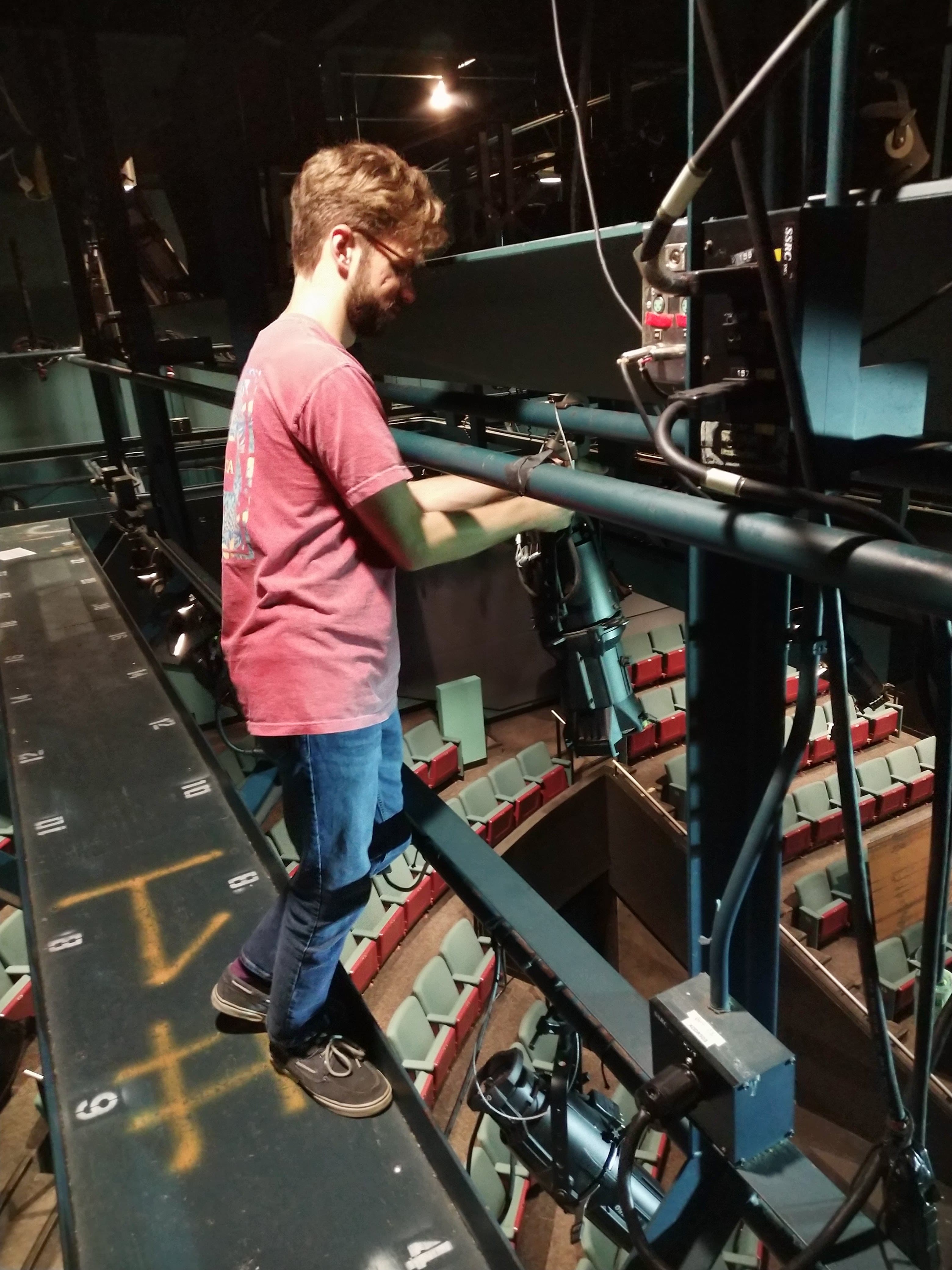
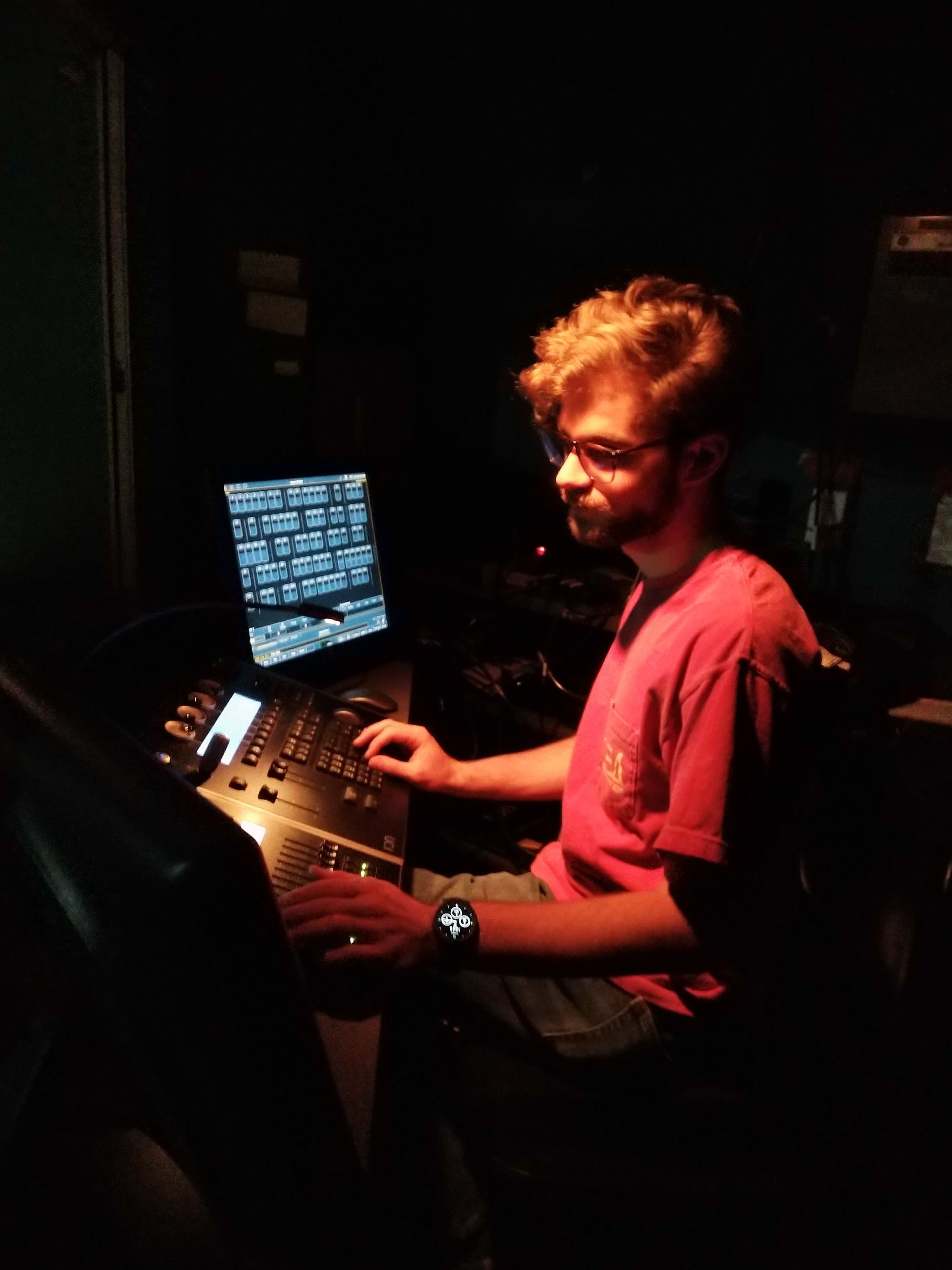
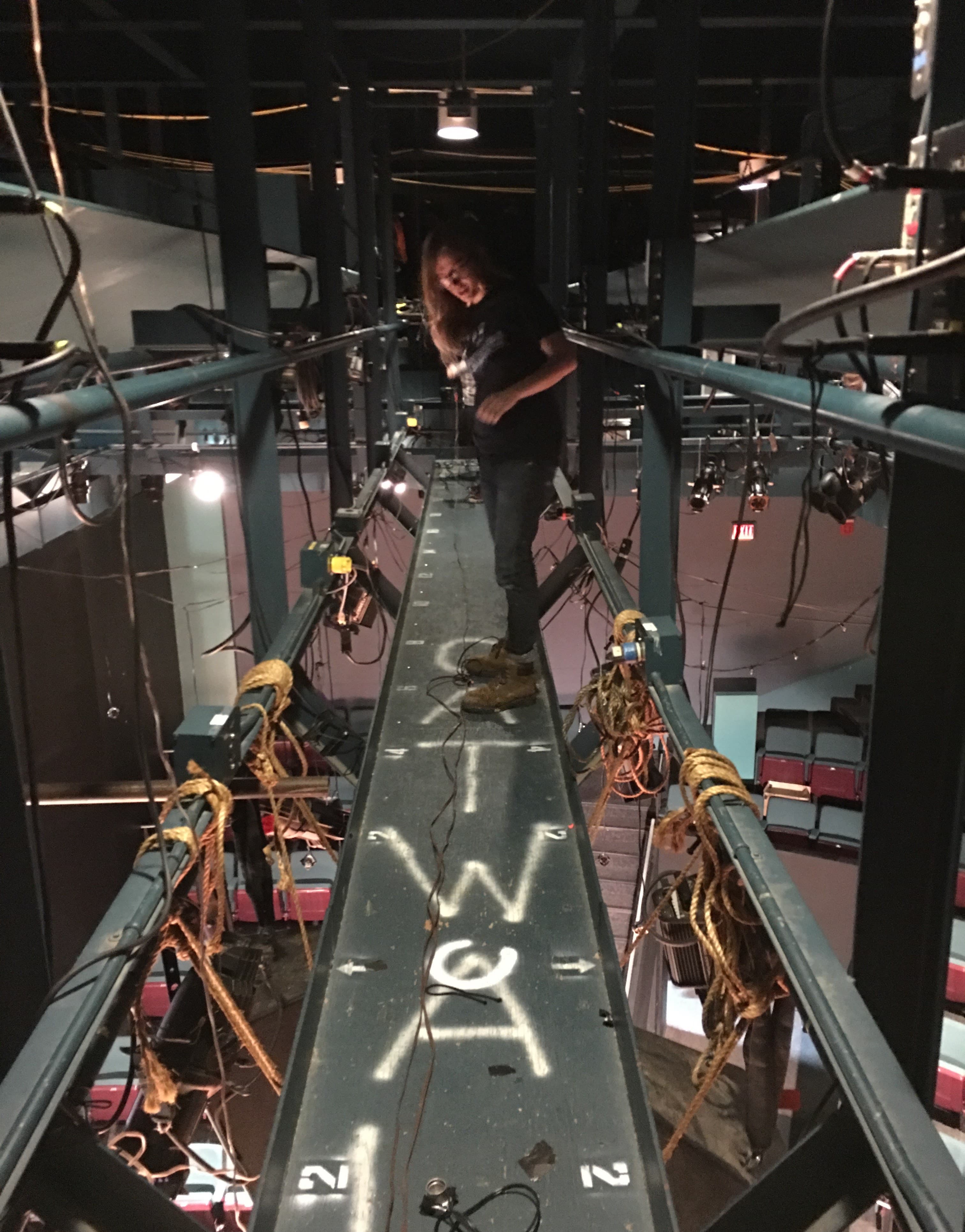
Costume Laboratory
Spring 2018 - Joshua Bond
In this lab, I primarily worked on wigs for A Funny Thing Happened on the Way to the Forum, one piece being the showgirl headdresses seen in the middle. In the lab I have learned how to hand-sew, use a sowing machine, and work with foam pieces.


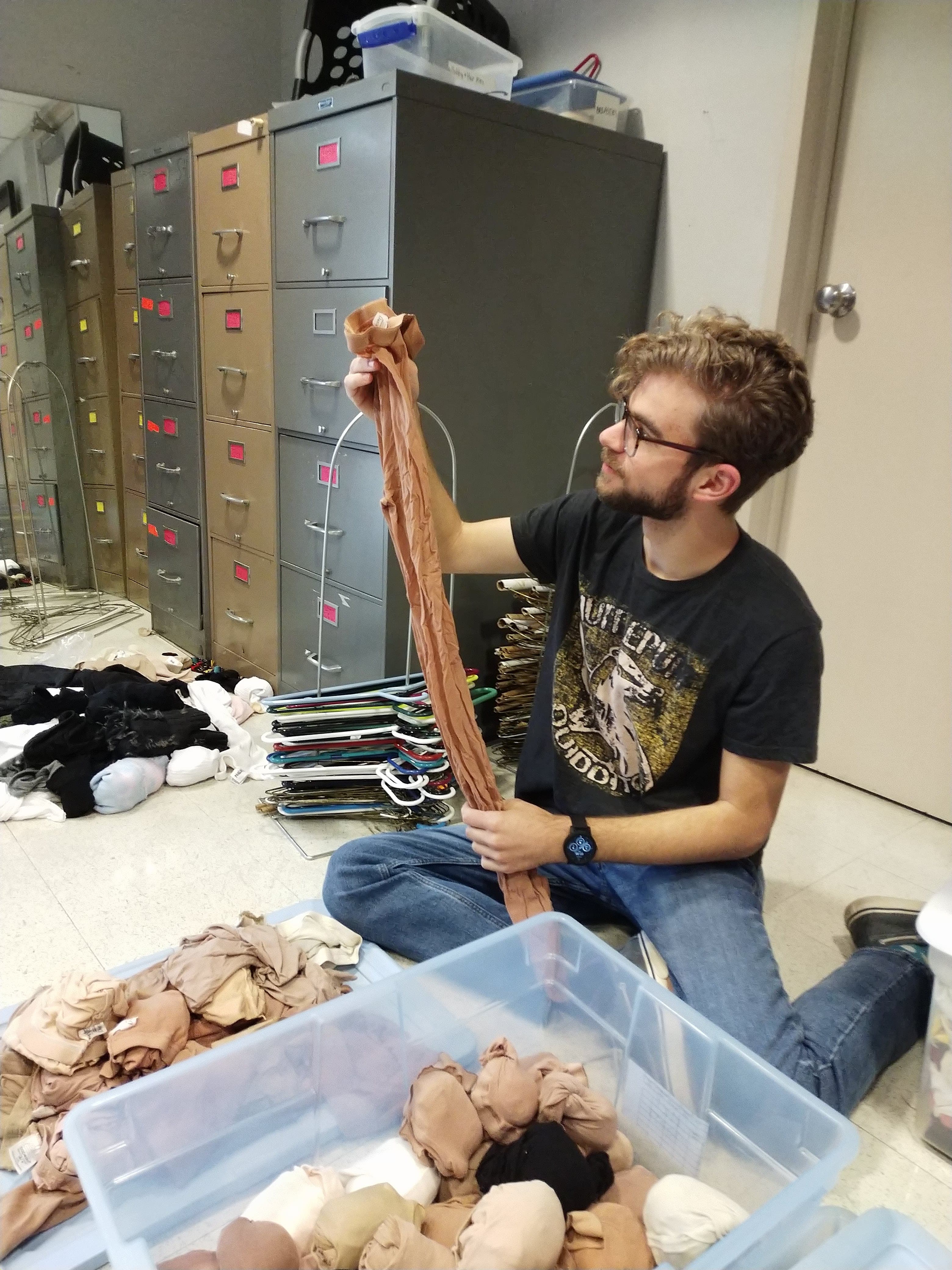
Scenic Laboratory
Fall 2016 - Justin Smith
In the scenic lab, I created flats, painted walls, dismantled a piano, and worked on many of the wood structures. I had a good knowledge of woodworking before attending Southwestern and was able to use and grow many of those skills in the lab.
